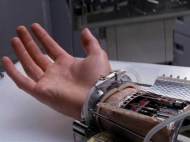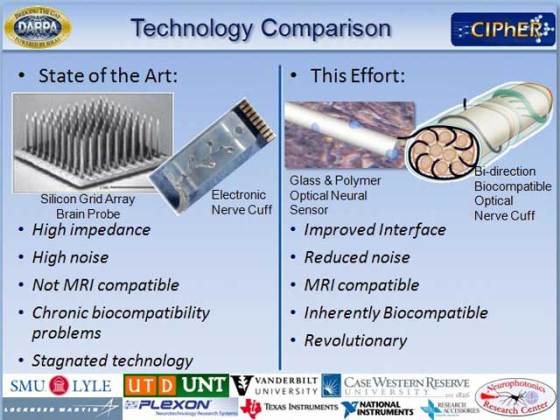SMU-led research aims to connect brain signals to robotic limbs
 Lightning-fast connections between robotic limbs and the human brain may be within reach for amputees. Funded by a Department of Defense initiative dedicated to audacious challenges and intense time schedules, the SMU engineers from Neurophotonics Research Center will develop two-way fiber optic communication between prosthetic limbs and peripheral nerves.
Lightning-fast connections between robotic limbs and the human brain may be within reach for amputees. Funded by a Department of Defense initiative dedicated to audacious challenges and intense time schedules, the SMU engineers from Neurophotonics Research Center will develop two-way fiber optic communication between prosthetic limbs and peripheral nerves.
Successful completion of the fiber optic link will allow for sending signals seamlessly back and forth between the brain and artificial limbs, allowing amputees larger freedom of movement and agility. Researchers in the Neurophotonics Research Center also envision man-to-machine applications that extend far beyond prosthetics, leading to medical breakthroughs like brain implants for the control of tremors, neuro-modulators for chronic pain management and implants for patients with spinal cord injuries.
“This technology has the potential to patch the spinal cord above and below a spinal injury”, said Marc Christensen, center director and electrical engineering chair in SMU’s Lyle School of Engineering. “Someday, we will get there.”
The goal of the Neurophotonics Research Center is to develop a link compatible with living tissue that will connect powerful computer technologies to the human nervous system through hundreds or even thousands of sensors embedded in a single fiber. Unlike experimental electronic nerve interfaces made of metal, fiber optic technology would not be rejected or destroyed by the body’s immune system.
“Enhancing human performance with modern digital technologies is one of the great frontiers in engineering”, said Christensen. “Providing this kind of port to the nervous system will enable not only realistic prosthetic limbs, but also can be applied to treat spinal cord injuries and an array of neurological disorders.”
The center brings together researchers from SMU, Vanderbilt University, Case Western Reserve University, the University of Texas at Dallas and the University of North Texas. The Neurophotonics Research Center’s industrial partners include Lockheed Martin (Aculight), Plexon, Texas Instruments, National Instruments and MRRA. Together, this group of university and industry researchers will develop and demonstrate new increasingly sophisticated two-way communication connections to the nervous system.
The center formed around a challenge from the industrial partners to build a fiber optic sensor scaled for individual nerve signals: “Team members have been developing the individual pieces of the solution over the past few years, but with this new federal funding we are able to push the technology forward into an integrated system that works at the cellular level”, Christensen said.
The research builds on partner universities’ recent advances in light stimulation of individual nerve cells and new, extraordinarily sensitive optical sensors being developed at SMU. Volkan Otugen, SMU site director for the center and Lyle School mechanical engineering chair, has pioneered research on tiny spherical devices that sense the smallest of signals utilizing a concept known as “whispering gallery modes”. A whispering gallery is an enclosed circular or elliptical area, like that found beneath an architectural dome, in which whispers can be heard clearly on the other side of the space.
“Science fiction writers have long imagined the day when the understanding and intuition of the human brain could be enhanced by the lightning speed of computing technologies”, said Geoffrey Orsak, dean of the SMU Lyle School of Engineering. “With this remarkable research initiative, we are truly beginning a journey into the future that will provide immeasurable benefits to humanity.”










Leave your response!